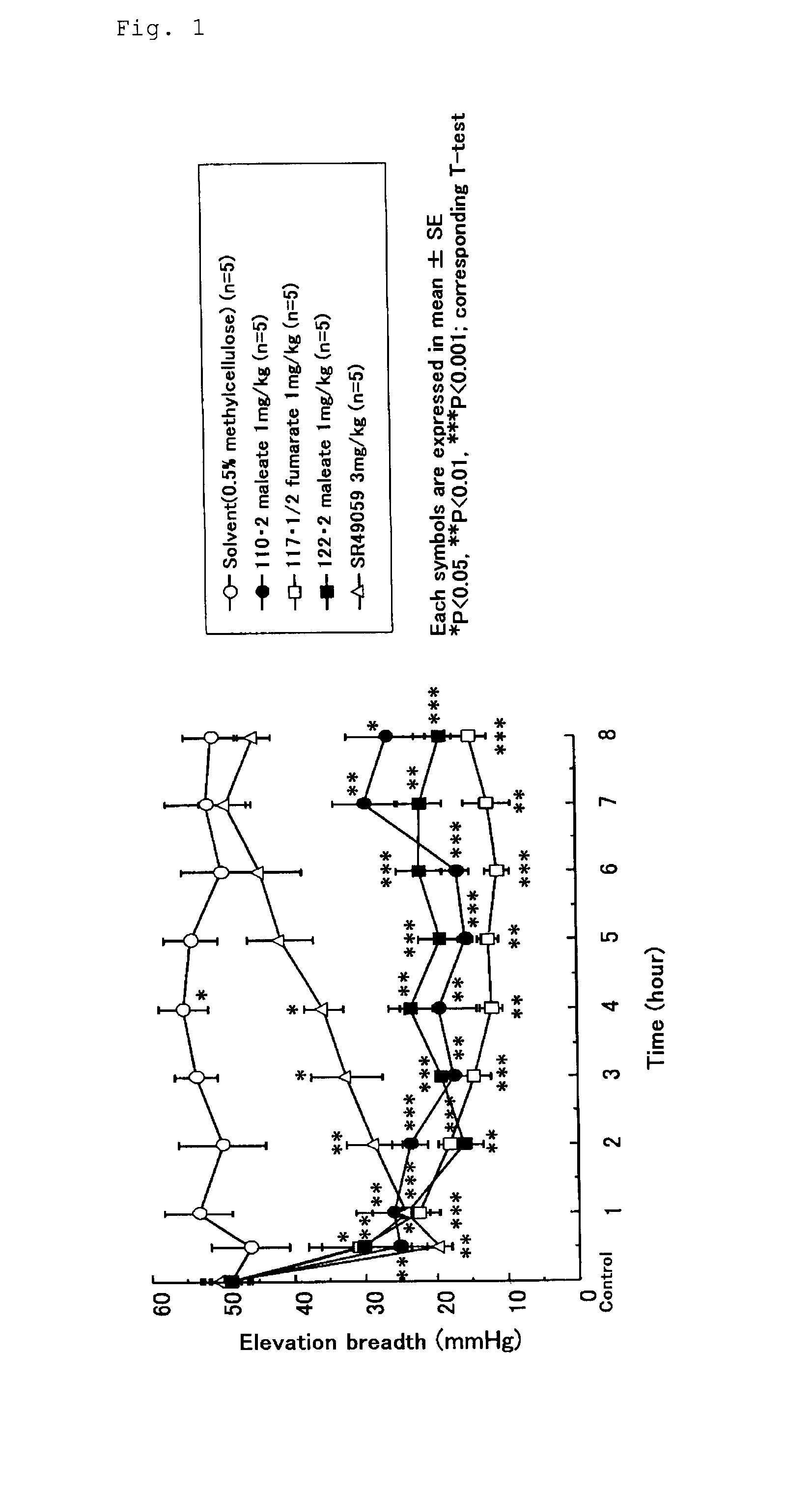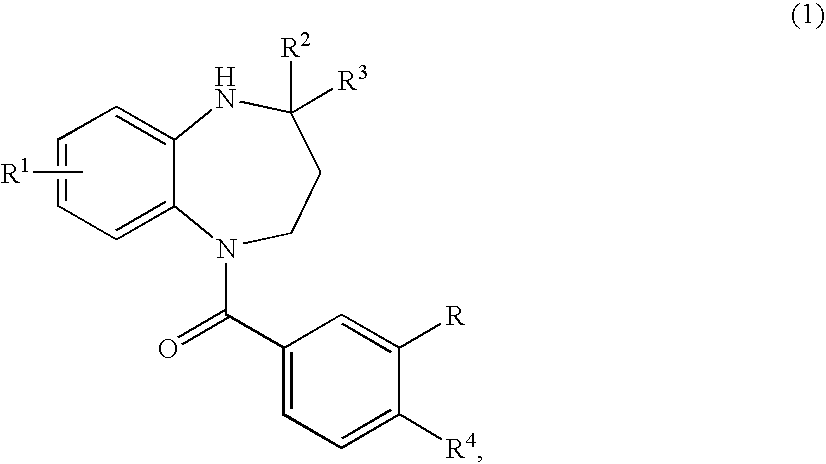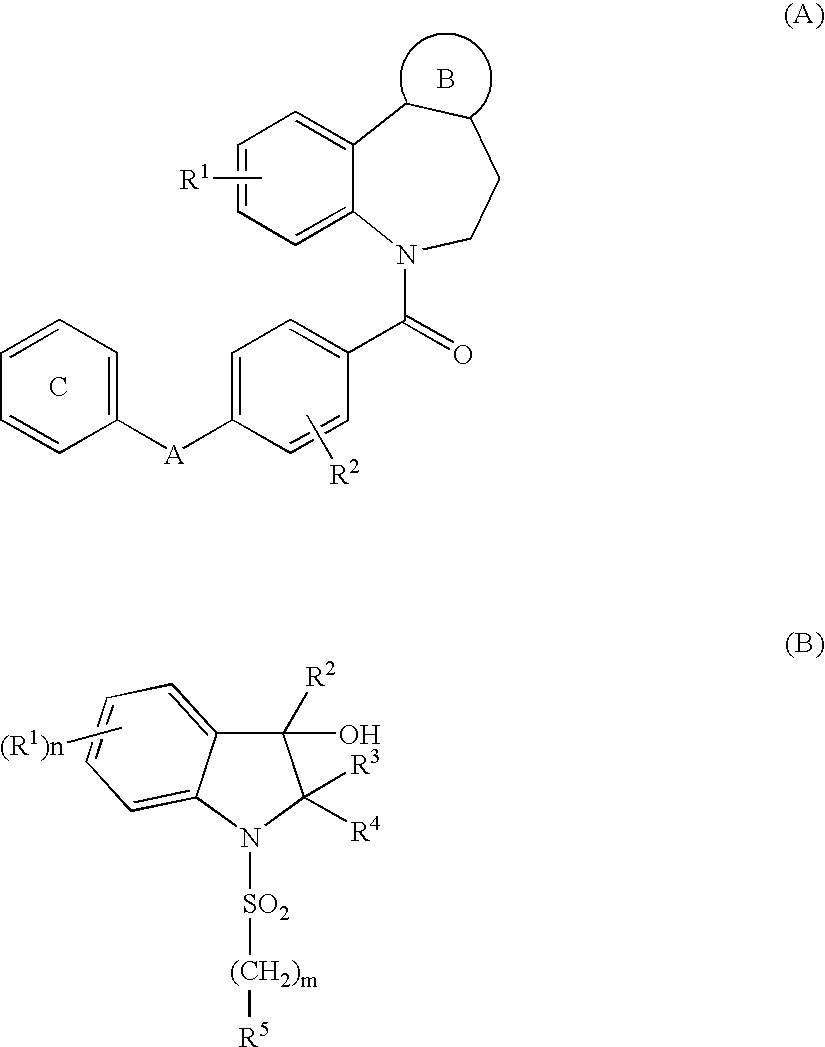2,3,4,5-tetrahydro-1h-1,5-benzodiazepine derivative and medicinal composition
- Summary
- Abstract
- Description
- Claims
- Application Information
AI Technical Summary
Benefits of technology
Problems solved by technology
Method used
Image
Examples
reference example 1
o-Phenylenediamine (5 g, 43.9 mmol) and crotonic acid (3.8 g, 44.1 mmol) was stirred at 150° C. for 7 hours. Distilled water (50 mL) and acetone (20 mL) were added to the reaction solution after cooling, and the precipitated solid was collected by filtration and dried under reduced pressure, to obtain 4-methyl-1,3,4,5-tetrahydro-2H-1,5-benzodiazepin-2-one (3.42 g, 44.2%) as white powder.
1H-NMR (CDCl3) δ: 1.33 (3H, d, J=6.6 Hz), 2.44 (1H, dd, J=13.9, 7.3 Hz), 2.65 (1H, dd, J=13.9, 4.4 Hz), 3.15-3.90 (1H, br), 3.97-4.09 (1H, m), 6.78 (1H, d, J=8.1 Hz), 6.86-6.91 (2H, m), 6.97-7.04 (1H, m), 7.76 (1H, brs) ppm
FABMS: 177 (M+1)
reference example 2
A methylene chloride solution (10 mL) containing benzoyl chloride (1.13 g, 8.01 mmol) was added dropwise to a methylene chloride solution (40 mL) containing the compound in Reference Example 1 (1.0 g, 6.16 mmol) and pyridine (0.73 g, 9.25 mmol) on ice. The reaction solution was stirred at room temperature for 12 hours. After reaction, the reaction solution was concentrated under reduced pressure, and the residue obtained was poured into a sodium hydrogen carbonate solution and extracted with ethyl acetate. The organic layer was washed with saturated aqueous sodium chloride solution, dried over anhydrous magnesium sulfate, and concentrated under reduced pressure. The residue obtained was purified by silica gel column chromatography (chloroform / methanol, 248:2), to obtain 5-benzoyl-4-methyl-1,3,4,5-tetrahydro-2H-1,5-benzodiazepin-2-one (1.52 g, 87.7%) as a brown oil.
1H-NMR (CDCl3) δ: 1.34 (3H, d, J=6.6 Hz), 2.41-2.62 (2H, m) 5.34 (1H, br), 6.71-6.74 (1H, m), 6.88-6.93 (1H, m), 7.08-...
reference example 3
The compound in Reference Example 2 (1.51 g, 5.39 mmol) was added to a tetrahydrofuran solution (40 mL) containing lithium aluminum hydride (1.61 g, 42.4 mmol), and the mixture was heated under reflux for 2.0 hours. Water was added to the reaction solution while the mixture was cooled with water. The mixture was stirred at room temperature for 15 hours and then filtered through Celite. The filtrate obtained was extracted with added ethyl acetate. The ethyl acetate layer was washed with water, dried over anhydrous sodium sulfate, and concentrated under reduced pressure. The residue obtained was purified by silica gel column chromatography (chloroform / ethyl acetate, 240:10), to obtain 1-benzyl-2-methyl-2-methyl-2,3,4,5-tetrahydro-1H-1,5-benzodiazepine (0.86 g, 63.2%) as a brown oil.
1H-NMR (CDCl3) δ: 0.96 (3H, d J=6.6 Hz), 1.54-1.66 (1H, m), 1.85-1.97 (1H, m), 3.02-3.11 (1H, m), 3.25-3.35 (1H, m), 3.41-3.450 (1H, m), 3.74 (1H, br), 4.19 (2H, m), 6.62 (1H, dd, J=7.3, 2.0 Hz), 6.72-6.8...
PUM
| Property | Measurement | Unit |
|---|---|---|
| Electrical conductance | aaaaa | aaaaa |
| Temperature | aaaaa | aaaaa |
| Temperature | aaaaa | aaaaa |
Abstract
Description
Claims
Application Information
 Login to View More
Login to View More - R&D
- Intellectual Property
- Life Sciences
- Materials
- Tech Scout
- Unparalleled Data Quality
- Higher Quality Content
- 60% Fewer Hallucinations
Browse by: Latest US Patents, China's latest patents, Technical Efficacy Thesaurus, Application Domain, Technology Topic, Popular Technical Reports.
© 2025 PatSnap. All rights reserved.Legal|Privacy policy|Modern Slavery Act Transparency Statement|Sitemap|About US| Contact US: help@patsnap.com



